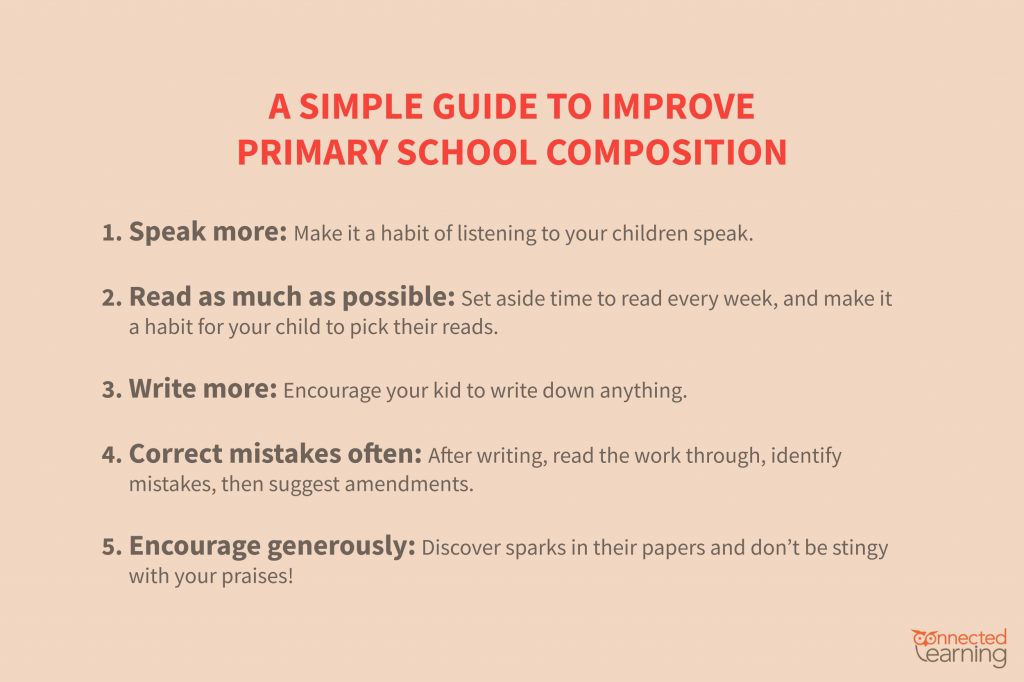Before getting down to a Chinese composition, the student needs to learn what makes it excellent—knowing how the questions work lets you cope with them efficiently.
Before we get into the step-by-step process of writing a tip-top Chinese Picture Composition, here’s a brief of you should know.
For a Picture Composition, there will be six pictures provided in the question. The first five depicts the beginning and climax of an incident, while the last image shows a question mark which requires students to plan and write a logical conclusion to the story.
Related: 8 Tips To Improve Chinese Composition In Primary School
The writing process
Try the following four-step process to write a piece of Chinese composition that’s up to the mark (and feel free to apply it to subsequent ones).
Step #1 Read the instructions carefully
Ah, the sweet, age-old advice. It’s a rule that seems so simple, but yet so hard to fulfil. Students often rush in exams when they get nervous. Teach your kid not to rush when they’re reading the instructions such as the minimum number of characters required. Also, the reference terms and phrases are great for setting the direction of the story context if students are at a loss.

Step #2 Observe the details of the pictures
While reading, it’s unimaginable how one can miss out on specific facts and details. Highlight keywords and/or phrases—anything that comes off as brow-raising or notable, or questionable—as well as making mental notes. Digression from the topic can cost huge marks, and this first step will ensure that pupils don’t get sidetracked. But, it’s wise not to spend too much time on this step as incompletion of work costs marks too! Also, the observation doesn’t end here. Train your child to interpret their observations. Carefully think about what these observations add up to—this will make step #4 easier.
Step #3 Think and decide on the prologue
Simply put, the prologue is the image before the first image. A preface is like a starter. It opens up the patron’s, in this case, the reader’s, appetite and provides a hint of what’s to come. Exceptionally accurate for picture composition, it’s implausible to create a story with rationale and reasoning by simply narrating what’s shown. A well-thought-out prologue gives necessary information on why the scenario in the pictures or the passage happened, helping readers understand the story better.
Related: 7 Expert-Approved Primary School Chinese Composition Writing Examples
Step #4 Think about the 5ws and 1h (or list them if there’s time)
There’s nothing worse than being caught in a jumble of messed-up thoughts. The 5ws and 1h—the final step in getting the skeleton of the composition secured—gives your little one a clear guideline of how the story should unfold, from the introduction to the passage, climax and the conclusion.
A simple guide to improving primary school composition
Students from primary three onwards will start to write compositions. The initial stages could be confusing, strange and discouraging. For parents to guide students through the writing process, take note of the following:

1. Speak more
“Speaking” means expressing what you see, hear, and think in words. Make it a habit of listening to your children speak. They can introduce people, things, natural scenery or hobbies, etc. Here’s a good activity: Hear them out for roughly 3 minutes and rearrange thoughts at certain parts where they seemed confused.
2. Read as much as possible
There’s a reason why reading has such a huge buzz. The novelist Stephen King once said, ‘If you don’t have the time to read, you don’t have the tools to write’. Set aside time to read every week, and make it a habit for your child to pick their reads.
3. Write more
Writing materials come from daily lives; things that you can see and hear. Encourage your kid to write down anything, be it a scene from a movie, or a piece of exciting news.
4. Correct mistakes often
The greatest teacher your kid will ever have is ‘mistakes’. After writing, read the work through, identify mistakes, then suggest amendments. Refrain from reprimanding mistakes. Instead, have genuine discussions or conversations with your child about these blunders. This little move can strengthen their comfort level at making mistakes and encourage them to face errors at ease in future.
5. Encourage generously
Not every piece of your child’s work will be spectacular. But there’s always something interesting in their writings. Anything counts; it could be great sentences, the emotions portrayed, concise train of thought, etc. Discover sparks in their papers and don’t be stingy with your praises!
Related: 8 Tips To Improve Chinese Composition In Primary School
Conclusion
As we mentioned, reading holds an unquestionably crucial part to improve writing, and it’s sensible to read religiously. Take 15 minutes each day to read extracurricular books. To make the most out of these minutes, jot down uncommon words, sentences, and your comments.
Kids having trouble learning, remembering and using new Chinese idioms, terms and phrases? Our tutors are trained to engage students in the lessons where they’ll be able to pick up new knowledge, and eventually produce promising and sophisticated pieces of writing in time to come. Hurry and sign up for a free trial lesson now!









